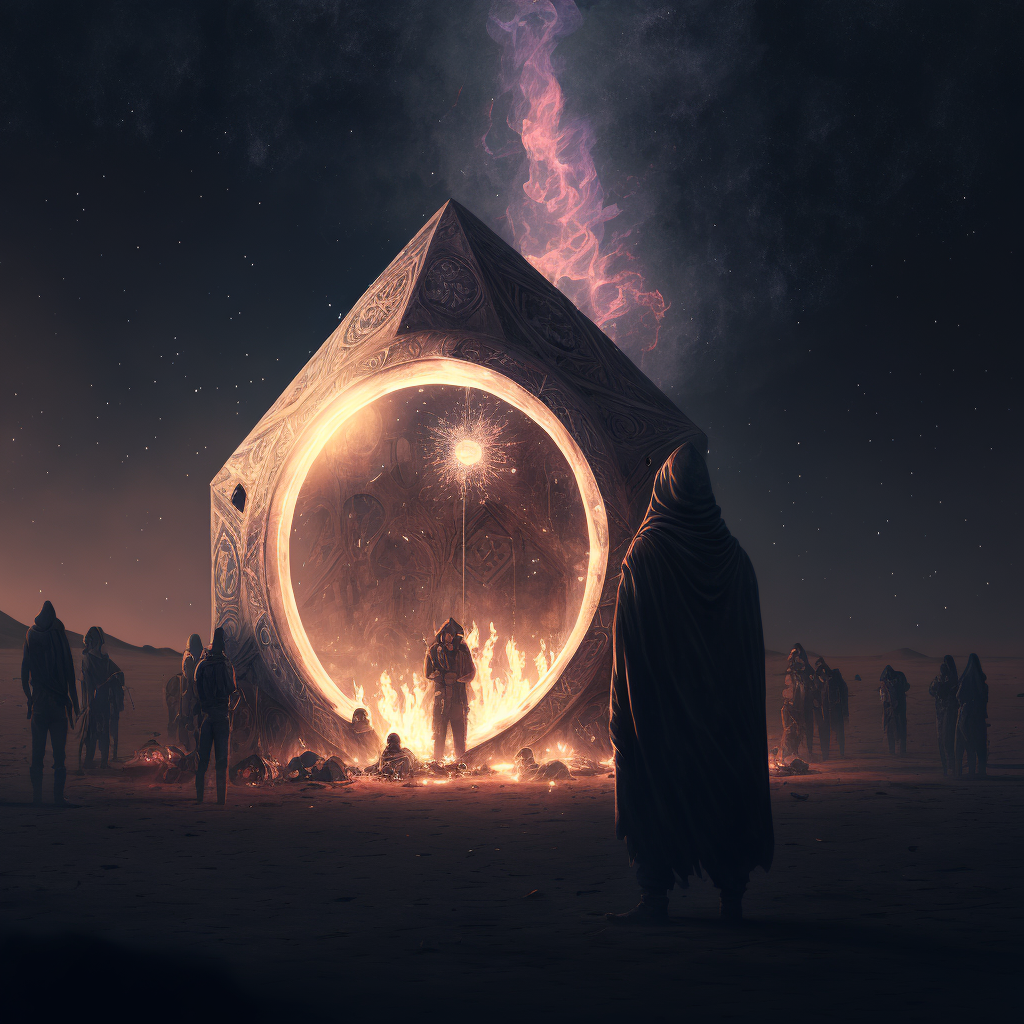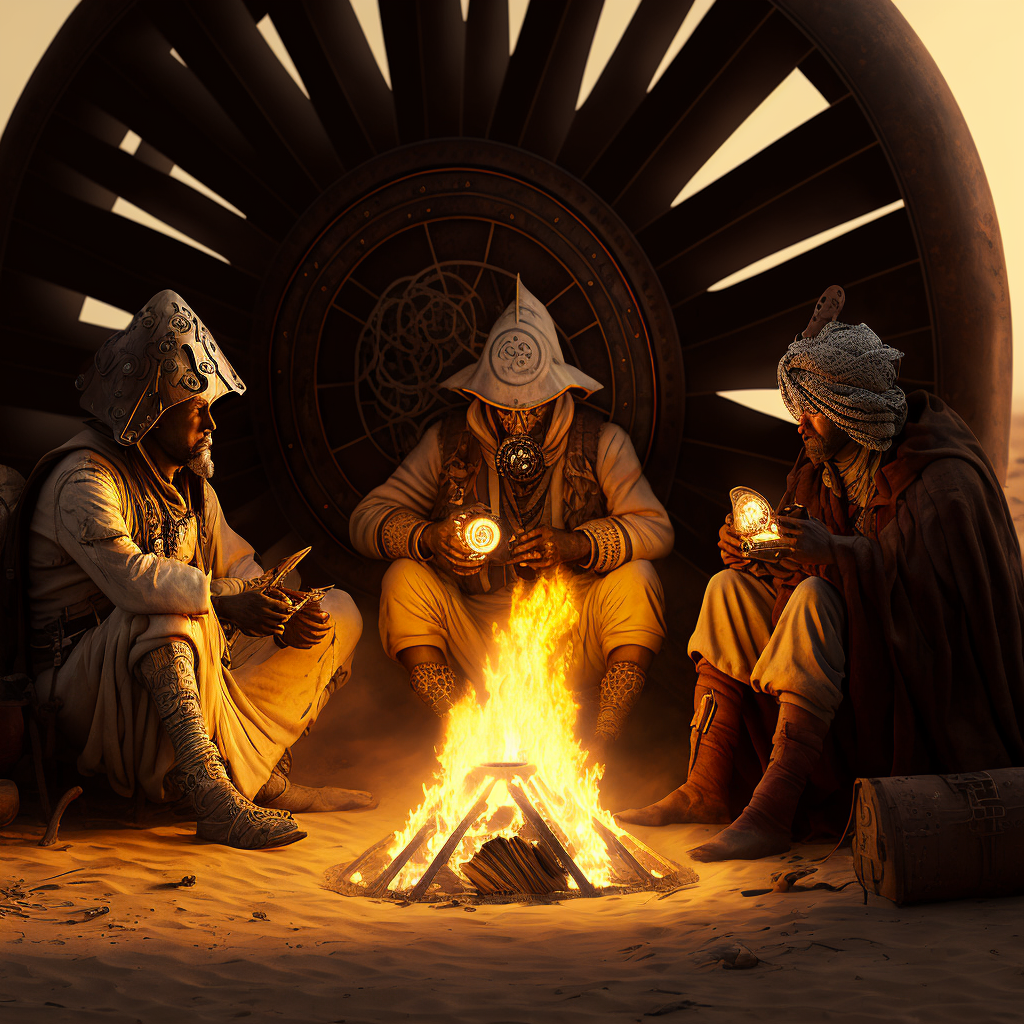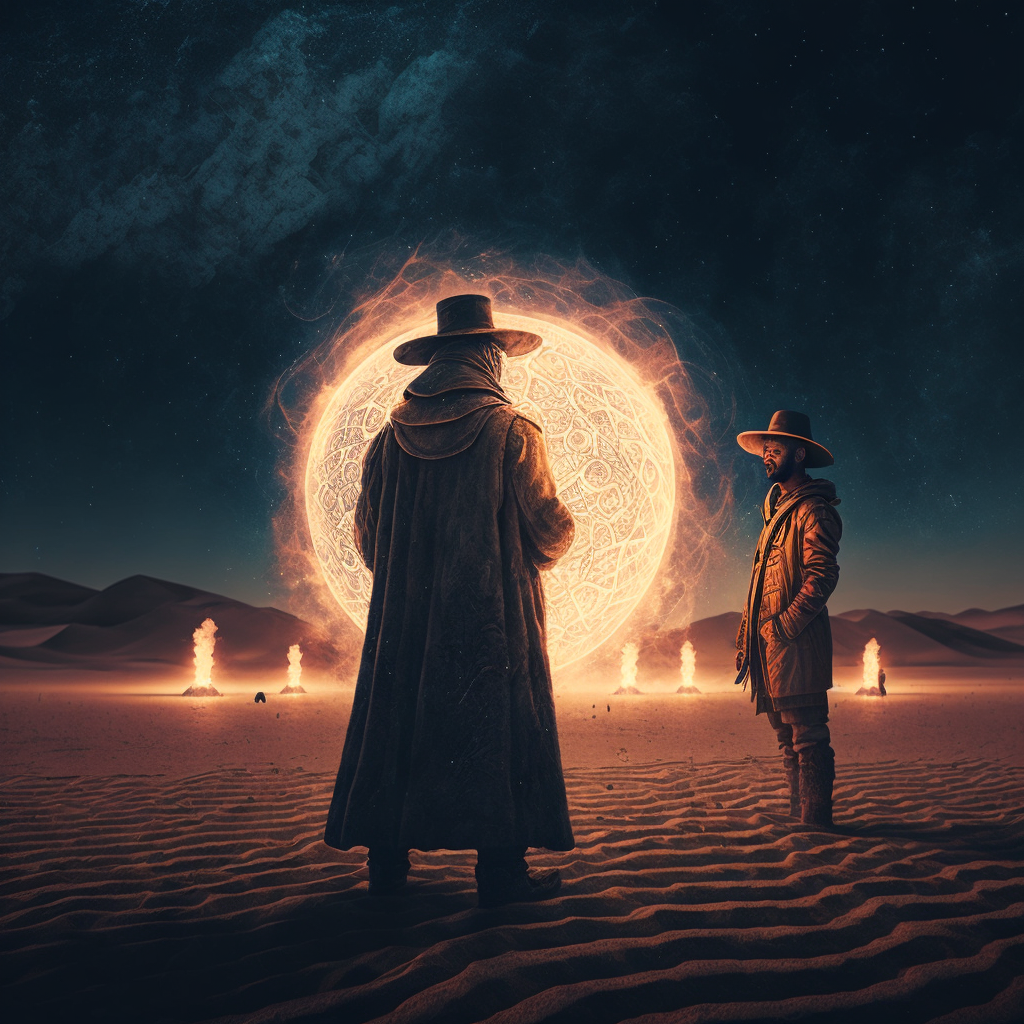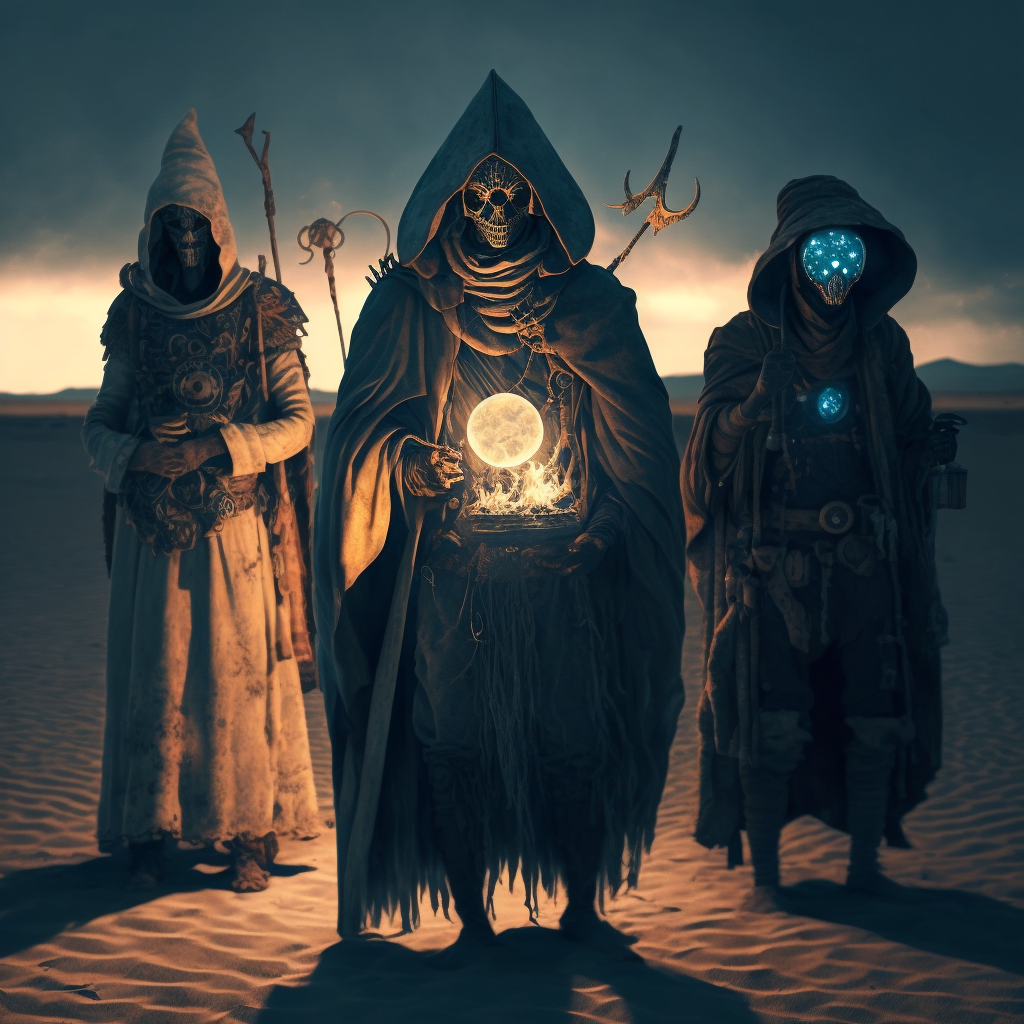Astrology, Free Will, and Creativity
San Francisco under the exaggerated influence of the outer planets, as imagined by midjourney
The creative process and the workings of the Muse are a mystery. Take my unpublished novel Corporate Mind, Cosmic Heart, for example. In 2013, when I had the seed of an idea to write about spiritual crisis, finding universal love inside, polyamory, and what it means to be free and a man in the 21st century, the idea seemed to coalesce out of nowhere. I always chalked it up to the osmosis of living in San Francisco, and having a culturally diverse group of friends who were into all sorts of things, like orgasmic meditation, Burning Man, weekend personal growth workshops, and ecstatic dancing to kirtanica at Harbin Hot Springs. And these themes obviously have dramatic tension built-in: Will Wyatt resolve his spiritual crisis? Will he learn to love himself? What happens when a monogamous man falls in love with a polyamorous woman?
As a result of an education that flowered out of the research for the novel in an ever-deepening spiral of grace and expansion, I now understand that there were deeper influences at work. Learning archetypal astrology the past two semesters in the philosophy, cosmology and consciousness (PCC) program at the California Institute of Integral Studies (CIIS) has opened my eyes to a whole new perspective on the archetypal, cosmic influences present during the gestation of my novel. I smile in wonderment at the fact that, in 2013, I ended up in an archetypal astrology Burning Man camp comprised of PCC students and alumni (and PCC professor Richard Tarnas) as a result of my book about spiritual crisis based on the work of Stanislav Grof, another luminary in the orbit of PCC, which then led me gradually into its inner orbit, where I could understand the archetypal forces at work more deeply.
As we will see, the energy of the time was very much Uranus+Pluto, infused with Neptunian mysticism and Venusian sensuality. This influenced the subject matter of the novel I was writing, but also did its transformational work on me, or motivated me to do that transformational work on myself.
The novel eventually turned out to be a magic portal I was fabricating in order to step through it into a new life. In a way, I was casting the novel like a great sail that I was unfurling into the cosmic winds blowing across the world in 2013.
So in this missive I would like to examine the celestial transits that seem to have played a major role in my decision to write a novel about spiritual crisis, polyamory, and what it means to be Robert Bly’s wild man in the 21st Century. I think it says something about astrology, free will, and the creative process.
Although I am a Vedic astrologer, I have been studying and quickly embracing archetypal astrology, due to the influence of Richard Tarnas and others.
An archetype is a universal principle or force embedded in the cosmos that affects the human psyche. Throughout human history, people have captured the essence of these forces through image and story. The quintessential archetype is the ancient deity—Apollo or Kali, or Oya, from the Yorùbá tradition. The planets, houses, and signs of astrology are also archetypes, and astrologers in all systems of astrology draw on these ancient deities and anthropomorphic symbols to help capture their archetypal flavor.
Carl Jung did much to elevate and popularize this archetypal way of looking at the world and its interplay with the human psyche. He posited that archetypes are the basic building blocks of the human psyche and universal expressions of a collective unconscious.
Archetypal astrology is a relatively new astrological practice that evolved out of depth psychology in the 20th century, building on the work of Carl Jung, James Hillman, and others. One advantage of archetypal astrology is that it sidesteps the whole tropical versus sidereal disunion between Western and Vedic astrology. It does this by focusing primarily on the relationship between the planets in a chart, and the relevant transits, rather than signs and houses.
In archetypal astrology, enormous emphasis is placed on the four outer planets—Saturn, Uranus, Neptune, and Pluto. In contrast, Vedic astrology traditionally ignores the outer three planets. The reason is partly historical and partly metaphysical, and does not concern us here.
In this post, because I am focusing on the influence of the outer planets in our solar system, I am going to peer exclusively through the lens of archetypal astrology, despite my deeper knowledge of Vedic astrology.
One final note before we continue: It can take time to adjust to archetypal thinking. With an archetypal perspective, Vedic and archetypal astrology can be understood as archetypally determinative or predictive, meaning that its influence is multivalent and not linear. This is what leaves space for the collaborative dance of human free will.
Creative Inspiration and Celestial Transits
I began writing my novel in the summer of 2013. At the time, the world was collectively well into the most recent Uranus+Pluto square, an archetypal dynamic echoing the Uranus+Pluto conjunction of the 1960s. As we will see, the Uranus+Pluto influence was operating on at least two levels: the themes I was exploring in the novel and my own inner and outer transformation.
We have also collectively been in a long Neptune-Pluto sextile, since about 1950, that will continue through 2032. More on that below as well.
The main astrological influences at the time were my midlife Uranus opposition conjunct with Venus, and Neptune squaring my natal Neptune. All of this was layered on top of, and emphasizing, my natal Neptune conjunct Jupiter, opposite Saturn.
I am not going to engage in a comprehensive astrological analysis. My purposes here are simply to sketch the relevant outlines in order to make a point about free will and creativity, and especially the importance of surrender in the creative process.
The Midlife Uranus Opposition
Uranus is the planet of change, rebellion, liberation, innovation, revelations and awakenings. Uranus takes 84 years to orbit the sun. So we experience a half Uranus return around the age of 42, precisely the age I was when starting this novel. Uranus transits one’s natal Uranus for approximately three years.
If one is open to it, this kind of personal transit period—where Uranus is more potent—can therefore be marked by creative awakenings and personal breakthroughs.
The major themes I was exploring in my novel captured this archetypal flavor: the spiritual crisis of Wyatt, the protagonist, is precipitated by his own Uranus midlife transit and completely upends his life. I had chosen to set Wyatt’s age at around 40. Granted, this is conventionally when midlife crisis emerge, especially for men. Understanding the impact of Uranus sheds light on that midlife crisis phenomenon. In any case, Wyatt’s midlife crisis is about so much more than his age. In the course of our journey with him in the book, we see how he is funneling the existential angst and crisis of meaning of our age and how it then manifests as spiritual crisis for him.
Wyatt was questioning his career and his whole way of living. And so was I. What does it mean to live authentically as a modern man (or any person)? Why are conventional office jobs that are supposed to feel like some sort of pinnacle of “success” so unfulfilling? What is the highest and best use of a sensitive, yet wild, man’s time and energy? In this age of turmoil, unraveling, and confusion, surely there is a deeper way to contribute than representing and defending tech giants as a lawyer. These are the questions I was trying to answer for myself.
Wyatt was propelled by these forces, as much as I was in creating him. But he could not answer these big questions for himself. He needed a guide, or a series of guides. Enter the wild and free Myranda and her counterculture community of Burners and non-monogamists.
As my long-time readers know, polyamory was another major theme in the novel, setting up the central tension between Wyatt and Myranda. This lifestyle is obviously very Uranian in its attempt to upend conventional relationships and create a wholly new way of living, one that is very much utopian in its design. Although it is not a lifestyle for everyone, including myself, it does invite us to aspire to our higher natures and transcend lower expressions like jealousy and control in relationships.
So, not only was I writing about these Uranus qualities in terms of the cultural and spiritual innovations my characters were experiencing, but I was going through intense transformation myself.
Not only did I have Uranus transiting my natal Uranus but I also had Venus transiting conjunct Uranus.
Venus and Eros
Venus was transiting my Uranus+Uranus conjunction at the precise moment I came up with the idea (and went to Burning Man for the first time with the camp that would eventually lead me to enrolling in PCC). Venus is romance, Eros, sensuality, sexuality, beauty, and the arts.
So, with the Uranus+Venus influence there is artistic stimulation and innovation, and a desire for romantic freedom (polyamory). You may recall from prior posts that my novel also featured a sex cult called the Orgasmic Human Institute (OHI), where several of the main characters were leaders and facilitators. A lot of people were exploring alternative ways of defining relationship at the time, and deepening the sexual liberation spiral from the 1960s. And it felt like San Francisco was leading the way. Every other person you met back then was poly or at least poly-curious.
Channeling that Venusian archetypal energy, my novel aspired to be sexy. I spent a fair amount of time attempting to perfect the art of writing a sex scene. It is incredibly difficult to write a sex scene that is tasteful yet titillating, artistic yet animalistic. If you have a favorite sex scene in literature, please let me know!
In short, the influence of Venus moving across my crowded tenth house stellium (Sun, Moon, Uranus, Pluto, and Mercury) and Uranus in particular was so obvious and potent in hindsight.
Neptune the Hippie
Neptune was also squaring my natal Neptune during this time, for about a year. Neptune is the planetary archetype of spirituality, the transcendent, mysticism, myth, and cosmic unity.
Corporate Mind, Cosmic Heart is deeply spiritual. Not only was Wyatt going through a spiritual crisis but, through the character of his love interest Myranda, I was exploring yoga, Neo-Tantra, Neo-Paganism, and Neo-Shamanism, explorations that would continue beyond the bounds of the book in subsequent years, including living and teaching at a yoga ashram in India and training to facilitate sacred plant medicine ceremonies, not to mention enrolling in PCC at CIIS. Although I was already a yoga teacher at that point, my own spiritual journey did not begin in earnest until this creatively verdant year 2013.
By putting Wyatt through a spiritual crisis in which he explores alternative lifestyles and spiritualities, I was giving myself permission to deepen my own inner exploration. I went to Burning Man for research initially (and ended up in a PCC camp). Wyatt did Ayahuasca before I did. Wyatt experienced an immense heart opening and learned to find love inside arguably before I did (still working on it).
Neptune can also engender confusion and getting caught in illusions. When we first meet them, many of the characters are lost and trapped in their own illusions. In a way, Wyatt’s journey is one of him learning to find the truth, learning techniques for discerning truth—spiritual practices.
Our Collective Uranus + Pluto Square
Not only was I feeling the intense influence of Uranus, the cosmic trickster, but as a collective, we were well into the most recent Uranus+Pluto square as well, from 2007 to 2020. The last time we experienced this alignment was from 1960–1972. So you can guess the archetypal dynamics that it delivers.
The archetype of Pluto brings elemental power, depth, and intensity. It is libidinal and aggressive, even volcanic and destructive. It is the will to power and the force of life. In short, deeply transformative and intensely so. Combined with Uranus it is a potent energy. Uranus+Pluto alignments are times of deep revolutionary change, social justice reform, technological innovation, and increasing sexual freedom. This was the archetypal engine behind the 1960s. And we just finished another round of it.
The potent combination of these two archetypes historically produces destruction, transformation, revolution, and rebirth in nearly every field of human endeavor. We saw this in the period from 2007 to 2020 in political uprisings like the Arab Spring and the Color Revolutions, as well as the rise of Trumpism in the United States, and protests from the Tea Party to Occupy Wall Street and Black Lives Matter. There was the Women’s March, legalization of same-sex marriage, and the #MeToo Movement. In terms of technological innovation, the period kicked off with the launch of the iPhone and the publication of Nakamoto’s cryptocurrency paper, not to mention the rise of the social web. And it goes without saying that the movements described above, from BLM to the Arab Spring to Trumpism would not have been possible without smartphones and social media.
So, not only was I in my Uranus opposition but I was swimming in the archetypal waters of this global Uranus+Pluto square. With this alignment, not only is Pluto a fiery engine driving the Uranus influence, but Uranus is awakening the Dionysian, Plutonic sexual libido as well. Pluto was roughly square with my natal Pluto and Uranus, intensifying and revolutionizing my life and inspiring me to write about a disruptive and tumultuous time in the lives of Wyatt and Myranda, two San Franciscans dedicated to authenticity and transformation in their own unique ways.
Uranus+Pluto periods are also often marked by the use of mind-expanding drugs or exploration of new consciousness practices (like yoga). Wyatt’s journey through the San Francisco of 2013 was very much influenced by this upsurge in the legalization and popularity of mind-expanding drugs, including his experience at Burning Man in a Neo-Shamanistic Ayahuasca ceremony, which takes place during the climax of the story.
If you are interested in delving more deeply into the vagaries of this most recent Uranus+Pluto cycle, I highly recommend the series Changing of the Gods.
The Evolution of Consciousness That Started In 1950
All of this was happening in this long Neptune+Pluto sextile we have been in since 1950, where a profound evolution of consciousness (Neptune) is unfolding, propelled by Pluto’s intense and transformative energy. The most recent prior Neptune+Pluto alignment last occurred in the 18th century, centered around the Enlightenment, the birth of Romanticism, and the American and French Revolutions. But the last time it contained within its cycle Uranus-Pluto and Uranus-Neptune conjunctions was five hundred years ago, when the modern, scientific self was birthed.
This underscores the immensity of the shift in worldview that we are experiencing, where old paradigms no longer satisfy, or provide a fulfilling cosmology.
My novel is very much concerned with the evolution of consciousness. Each of the main characters is invited to embark on a journey through some sort of profound expansion of consciousness. Some accept the invitation while others resist it. Wyatt is dragged unwillingly through his transformation, until he begins to embrace it in the second half of the novel. In contrast, Myranda, although further along than Wyatt initially, has become scared of what her own evolution will require and is stuck. This is where Wyatt helps her to identify her own blindspots, as in any relationship. Part of the central tension in the larger story is whether they will openly accept the invitation to walk each other home, or instead succumb to their trauma and triggers.
Surrender and the Creative Dance
What can we do with this knowledge of astrological transits and their influence on the muse?
First, awareness of the hidden forces informing the zeitgeist can cast a new, more edifying light on those forces and allow us to dance with them more intentionally. The more tapped in to the spirit of the time we are, the more we can be relevant to the grand unfolding, and even steer the content of our psyches out to the cutting edge of the tide of humanity, shining a light for others. We can write the next Grapes of Wrath or 1984 or One Hundred Years of Solitude. Not that I am going to write something of that stature. Perhaps you will.
More importantly, this is the perfect explication and illustration of the elegant way in which the Cosmos archetypally influences events in the world, such that there is room for human free will, in a collaborative dance in which the finite expressions of the Infinite create the present and the future together. Archetypal astrology underscores and harmonizes with the ancient Yog-Vedantic view: The universe is ensouled and, because we are born out of and through the Cosmos, we participate in its unfolding. We do not have complete control, nor are we at the mercy of determinist forces. Instead, we dance.
As in life, grace and success flows more naturally once we surrender any illusion of control. Through spiritual or creative practice, we realize that we are not so much the masters of our destiny as collaborators of a future we are co-creating with the Divine.
Reflecting on these astrological influences, I realize that perhaps the novel was more autobiographical than I realized at the time. I liked to tell people that it was not autobiographical but, rather, a reverse autobiography in that I was creating a character, doing experiential research in support of that character’s arc, thereby gradually becoming a living version of that character in many ways. But I see now that it was an elaborate way to form a new personality that was not me.
Whether I end up turning it into a polished novel or screenplay, I am grateful for the disruptive way that Uranus, Pluto, and Neptune revolutionized my life. It hasn’t always been easy but I’ve done my best to hold on to the tail of this rocket for dear life. More and more I have come to see the novel and the years I spent writing it full time as a deep alchemical process in which I opened to the mysteries of the Cosmos and did my best to listen, to write down everything I was hearing, and to share the lessons with the world. The lessons continue. I have stepped through the wardrobe and embraced my life here in Narnia.
Let me know if you have had a similar experience with particular transits in your own creative endeavors.
Astrology Readings with Me
Although I’m a practicing Vedic astrologer (Jyotishi), I have developed a deep appreciation for archetypal astrology and its particular emphasis on the four outer planets, three of which we don’t use in Jyotish. So I am working on a new synthesis of the two systems, and I have begun incorporating the three outer planets into my Vedic astrology readings.
Having said that, what I love about Jyotish is that, because it’s part of the larger Yog-Vedantic tradition, it draws on the incredible depth and breadth of yogic practices and knowledge to offer yoga practices custom-tailored to your chart, and any areas highlighted in your reading that deserve special attention.
The Benefits of a Reading: A Jyotish reading will help you to know yourself better – understand your place in the world more deeply, and your dharma in this life, and gain clarity into the various seasons of your life. Astrology helps you to approach so-called obstacles in your life with greater grace, establishing the deeply-held feeling that no experience is too big for you to handle, that there is nothing to fear in life.
What’s Included In A Reading: A 90-minute live reading on Zoom or in-person where we explore your natal chart and current transits to identify opportunities for growth, in the context of specific questions you may have. You also receive a separate, 30-minute practice session to dive more deeply into the yogic practices we identified in your chart and transits. These practices can include asana, kriya, pranayama (breath work), sacred rituals, and dietary changes like fasting.






